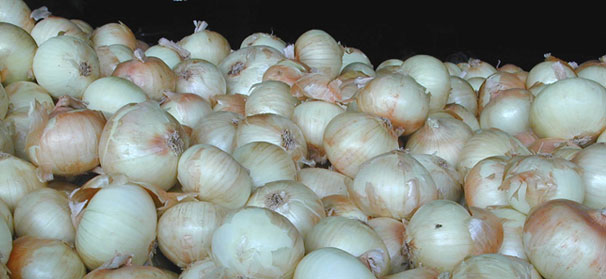

May 21, 2012Growers increase market share by shrinking onions
Georgia’s Vidalia onion farmers have spent the last few growing seasons working to produce smaller versions of their prized onions, which are typically some of the largest onion varieties in the produce department.
“I’ve always thought that if a slice was bigger than a loaf of bread or bigger than a hamburger bun, it might be too big,” said Reid Torrance, coordinator of the University of Georgia’s (UGA) Vidalia Onion and Vegetable Research Center in Toombs County.
For years, consumers demanded giant-sized onions that could be used in different fried-onion recipes or wrapped in foil and thrown on the grill. Shoppers would pay more money per pound for larger onions.
In response, farmers worked to grow the largest onions they could, but the era of the super-sized onion appears to be over. The public now wants smaller onions that can be used in recipes found online, said Cliff Riner, UGA Extension coordinator for Tattnall County.
“The onion varieties we have now will get as big as you will let them,” Riner said. “When we first had the ability to grow these colossal onions, there was a premium for that size. But now most recipes on the Food Network and other places call for one large onion or two medium onions, so that’s what the market is calling for.”
To dovetail with market demand, farmers should produce about 60 percent jumbo onions, with 3- to 4-inch circumferences, and about 40 percent medium onions, with 2- to 3-inch circumferences.
However, growing those smaller onions can be tricky.
Shrinking onions
If farmers simply pull the onions out of their fields earlier, they won’t be as sweet. People expect a certain quality and taste from Vidalia onions, and to maintain that quality, each onion has to stay in the ground for a certain amount of time, Riner said.
The challenge is to slow the growth rate of the onion, so that it can fully ripen in the field before it becomes the size of a softball.
“We’re trying to slow down these racehorse onions,” Riner said.
Farmers have been working for the past few years with Extension onion experts, like Riner and Torrance, to find the varieties and growing conditions that will produce smaller onions.
They’ve tried different varieties, crop spacing and fertilization and irrigation methods to control the size. Shoppers should start to see more medium-sized Vidalia onions in their produce departments soon.
Because of the early spring weather, some farmers had already harvested part of their crops by mid-April, but most were just kicking off harvest season, Riner said.
Despite the abnormally warm winter, the crop was shaping up well. It looked like farmers would be sending a solid supply of Vidalia onions into the market, Torrance said.
The 100 growers certified to grow Vidalia onions farm about 12,000 acres and produce about 5 million 40-pound boxes of onions each season, according to the Vidalia Onion Committee.
By Merritt Melancon, University of Georgia














